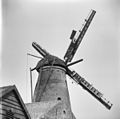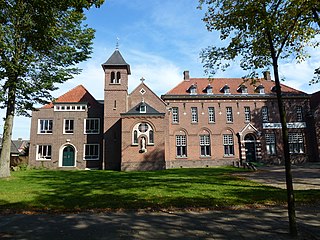
De Grote Molen is a smock mill in Broeksterwâld, Friesland, Netherlands which has been restored to working order. The mill is listed as a Rijksmonument, number 11679.

Welgelegen or Tjepkema's Molen is a smock mill in Heerenveen, Friesland, Netherlands, which was built in 1849 and has been restored to working order. The mill is listed as a Rijksmonument, No. 21171.
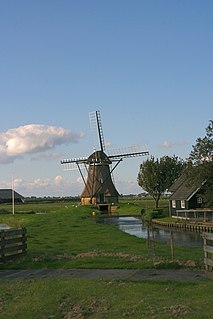
De Huinsermolen is a smock mill in Húns, Friesland, Netherlands which was built in 1829. The mill has been restored to working order. It is listed as a Rijksmonument, number 8530.

De Sweachmermolen is a smock mill between Langweer and Boornzwaag, Friesland, Netherlands which was built in 1782. The mill has two functions: it is a drainage mill and a corn mill. It has been restored to working order as a drainage mill and is listed as a Rijksmonument, number 13241.
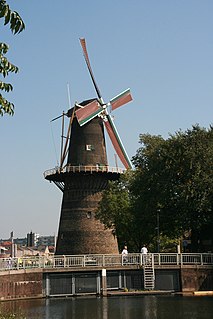
De Noord is a windmill located on the Noordvest 38 in Schiedam, Netherlands. It is the tallest windmill in the world with a roof height of 33.3 metres. Its wing span is 26.6 metres. The mill is one of the five remaining windmills in Schiedam, and is a national monument since 29 May 1969. Today De Noord houses a restaurant.

De Eenhoorn is a paltrok mill in Haarlem, North Holland, Netherlands which has been restored to working order. As all Dutch paltrok mills it is a windpowered sawmill. The mill is listed as a Rijksmonument, number 19872.

The Buitenmolen is a tower mill in Zevenaar, the Netherlands which was restored to working order in 1970. The mill was built in the beginning of the sixteenth century and is listed as a Rijksmonument, number 40427.

Tot Voordeel en Genoegen is a windmill built in 1798 on the Molendijk 15 in Alphen, Gelderland, in the Netherlands. It is a large post mill, built above a roundhouse, used for grinding wheat flour. It is the only windmill in the Netherlands that drives three pairs of millstones. The mechanism is mostly wooden, since iron was expensive when it was built. The windmill, which is still functional, can be rotated on its post to face the wind for maximum effect.

Op de Vrouweheide is a windmill located on the Vrouwenheide just south of Ubachsberg, Voerendaal, in the Dutch province of Limburg. Build in 1858 as a tower mill, on an artificial hill, the windmill functioned as gristmill. The mill is a national monument since 17 January 1967.

Aan de Pegstukken is a windmill located on De Pegstukken 27 in Schijndel, North Brabant, Netherlands. Built in 1845 on an artificial hill, the windmill functioned as a gristmill. The mill was built as a tower mill and its sails have a span of 25.25 metres (82.8 ft). The mill is a national monument since 19 September 1973. The name of the mill comes from the street it is located on.

De Adriaan is a windmill located on the Windmolen 17 in Meerveldhoven, a neighbourhood of Veldhoven, North Brabant, Netherlands. Build in 1906 on an artificial hill, the windmill functioned as gristmill. The mill was built as a tower mill and its sails have a span of 26.20 meters. The mill is a national monument since 1 October 1969.

De Akkermolen is a 17th-century windmill in Zundert, Netherlands. Built around 1605 to replace an earlier windmill, it was used as a gristmill until it was severely damaged in 1950. The mill was bought by the local government and restored in 1961, and it was listed as a national heritage site in 1974.

De Arend is a windmill located on the Molenstraat 40 in Terheijden, Drimmelen, in the province of North Brabant, Netherlands. Built in 1742 the windmill functioned as a gristmill. The mill was built as a tower mill and its sails have a span of 24.80 meters. The mill is a national monument since 19 May 1971. The mill is still in use and is property of the municipality of Drimmelen. It is open to public viewing.

The Annemie is a windmill located on the Boschdijk 1006 in Eindhoven, in the province of North Brabant, Netherlands. Build in 1891 on an artificial hill, the windmill functioned as gristmill. The mill was built as a tower mill and its sails have a span of 25 meters (82 ft). The mill is a national monument since 15 August 1972.

De Arend is a windmill located on the Akkerstraat 11 in Wouw, Roosendaal, in the province of North Brabant, Netherlands. Built in 1811 on an artificial hill, the windmill functioned as a gristmill. The mill was built as a tower mill and its sails have a span of 25.85 metres (84.8 ft). The mill is a national monument since 24 June 1971.
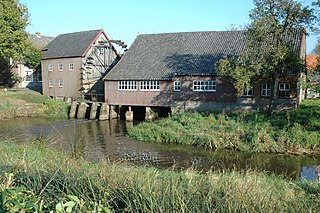
The Watermill at Opwetten is a watermill along the river Kleine Dommel, located on the Opwettenseweg 203 in Opwetten, Nuenen, Gerwen en Nederwetten, in the province of North Brabant, Netherlands. First mentioned in the 11th century, the watermill burned down and was rebuilt in 1764.

Boezemmolen is a smock mill in Tijnje, Friesland, Netherlands which was built in 1856 and dismantled in 1911. Formerly converted to residential use, the mill is under restoration. It is listed as a Rijksmonument.

De Hoop is a tower mill in Arnhem, Gelderland, Netherlands which was built in 1846 and is in working order. The mill is listed as a Rijksmonument.

The Watermill at Kollen is a watermill along the river Kleine Dommel, located on the Collseweg 1 in 't Coll, Eindhoven, in the province of North Brabant, Netherlands. First mentioned in the 14th century, the watermill burned down and was rebuilt in 1681.







